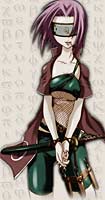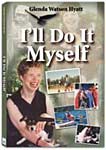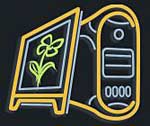Tech tips, geeky how-tos, thoughtful analysis of issues, news about the latest gadgets, ideas for improving your blog—you’ll find it all in these 10 terrific tech and science blogs. They just happen to be written by women.
I. Hacker Chick
 The Hacker Chick Blog is a beautiful starting point. I say beautiful because the graphics on this blog are stunning: everything from the image representing the hacker chick (software developer Abby Fichtner) to the icons and images used as illustrations are visually outstanding. Hacker Chick writes about designing WordPress themes, agile computing, programming, social media, and business.
The Hacker Chick Blog is a beautiful starting point. I say beautiful because the graphics on this blog are stunning: everything from the image representing the hacker chick (software developer Abby Fichtner) to the icons and images used as illustrations are visually outstanding. Hacker Chick writes about designing WordPress themes, agile computing, programming, social media, and business.
In Build Your Startup From the Heart, she said,
The world, it seems, is changing. If you ask Daniel Pink, he’ll say that our “left-brained” aptitudes — logical, analytical skills, the types of things schools reward us for — are no longer sufficient if we want to remain competitive. These are, after all, the very things being automated by computers and outsourced at rates we can’t compete with if we want to pay our mortgages, or, say, eat.
If we truly want to succeed, we need to pull in those right-brained skills that our schools & employers have tried so hard to beat out of us — artistry, empathy, play, and story telling.
You don’t find many programmers who think this way, or who can pull it together the way Hacker Chick does.
II. Pars3c
 Elizabeth Howell has her head in the stars with her blog Pars3c. The blog is pronounced “PAR-seck,” and astronomical term that gives you an idea of the topics you’ll find on the blog. This blog is about astronomy, spaceflight, science and telescopes. Big telescopes.
Elizabeth Howell has her head in the stars with her blog Pars3c. The blog is pronounced “PAR-seck,” and astronomical term that gives you an idea of the topics you’ll find on the blog. This blog is about astronomy, spaceflight, science and telescopes. Big telescopes.
In 500 explosions, 500 reasons to love satellites, Elizabeth said,
I’ve said this before, and I’ll say it again — the greatest thing about space-borne observatories is they have 24-hour darkness to enjoy. This makes it easier to catch fleeting cosmic events, even explosions.
Like that moment last month when NASA’s Swift telescope saw its 500th gamma-ray burst.
III. Blogger Buster
 Blogger Buster is for Google Blogger users. It’s written by Amanda Kay. Blogger templates and tutorials are the heart of this blog.
Blogger Buster is for Google Blogger users. It’s written by Amanda Kay. Blogger templates and tutorials are the heart of this blog.
For example, you can learn about 90 Related Posts with Thumbnails for Blogger – New Version by BloggerWidgets
Aneesh of Blogger Widgets has developed a new “Related Posts” script for Blogger which displays thumbnails of images in addition to linked post titles.
In appearance, this Blogger “add-on” is similar to the LinkWithin script. Each section is highlighted in a complementary colour when the mouse hovers over it, and the entire section is clickable, leading to the URL of the “related post” displayed.
IV. Girl Developer
 Girl Developer is written by Sara, a software engineer. Her topics range among .net and WAN, tech events, software reviews, and life as a developer. There’s always a dash of style and humor in the mix. Recently she wrote about Meeting Wendy Friedlander, a fellow developer who is undergoing cancer treatment.
Girl Developer is written by Sara, a software engineer. Her topics range among .net and WAN, tech events, software reviews, and life as a developer. There’s always a dash of style and humor in the mix. Recently she wrote about Meeting Wendy Friedlander, a fellow developer who is undergoing cancer treatment.
Meeting Wendy prompted her to put together a fund-raising dinner:
I put this dinner together because I think it would be wonderful if we could all help Wendy a little as a community. She’s one of our own and it really could be any one of us. We’re having a dinner for Wendy, and if you’re in the NYC area and can make it we’d love to have you. It will be a great time of fellowship with other developers and I’m looking forward to it. If you can’t make the dinner or aren’t from the area there is a paypal link here for donations.
V. Do it Myself Blog
 Do it Myself Blog is the work of Glenda Watson Hyatt, the left-thumb blogger—so called because she types only with her left thumb due to her cerebral palsy. Glenda writes about accessibility on the web and in life, about events she attends and speeches she gives with the help of her computer’s voice, about new technology, entrepreneurship, and trying to find an accessible bathroom while at tech events.
Do it Myself Blog is the work of Glenda Watson Hyatt, the left-thumb blogger—so called because she types only with her left thumb due to her cerebral palsy. Glenda writes about accessibility on the web and in life, about events she attends and speeches she gives with the help of her computer’s voice, about new technology, entrepreneurship, and trying to find an accessible bathroom while at tech events.
Lately Glenda has been searching for the perfect app for her iPad that will help her with chores like making hair appointments and ordering burgers. In The iPad as an Affordable Communicator: A Follow-up Review, she commented
While I was at the mall last Tuesday, i also made a hair appointment. In the old days I would have typed a note before leaving home. Or, I would have asked Darrell to call for an appointment.
Tuesday i pulled out my iPad, typed a message in the Proloquo2Go app and showed it to the receptionist. An appointment was made for the following day.
All is not golden with the Proloquo2Go app, however, as Glenda discovers when she tries to order food.
VI. Apophenia
 Apophenia is danah boyd’s blog. This blog deals with big ideas. It focuses on issues: trends, analysis, data about how young people use technology, and topics like privacy.
Apophenia is danah boyd’s blog. This blog deals with big ideas. It focuses on issues: trends, analysis, data about how young people use technology, and topics like privacy.
In “for the lolz”: 4chan is hacking the attention economy , danah explains what 4chan is with a “Newbie Note” before she begins her discussion of the site:
Newbie note: If you have never heard of 4chan, start with the Wikipedia entry and not the website itself. The site tends to offend many adults’ sensibilities. As one of my friends put it, loving LOLcats or rickrolling as outputs is like loving a tasty hamburger; visiting 4chan is like visiting the meat factory. At some point, it’d probably help to visit the meat factory, but that might make you go vegetarian.
danah boyd is quite possibly one the the smartest people on the planet, so running big ideas through her mind and getting to read the results of her thinking on her blog is a true privilege.
VII. The Female Perspective of Computer Science
 The Female Perspective of Computer Science is from Gail Carmichael, who is working on a doctorate in Computer Science. Her fields of study include educational entertainment and augmented reality, both of which get discussed on the blog. Other topics include visual computing, games, events, computer science, and women.
The Female Perspective of Computer Science is from Gail Carmichael, who is working on a doctorate in Computer Science. Her fields of study include educational entertainment and augmented reality, both of which get discussed on the blog. Other topics include visual computing, games, events, computer science, and women.
Recently she wrote about Getting the Hang of iPhone Development.
I needed to learn how to develop for the iPhone since the projects I want to work on next will be games for the device. This task was somewhat daunting, given that I hadn’t really even used a Mac before, let alone Objective-C or Xcode. Luckily, there are some really great resources out there that you should check out if you are also just getting started.
So far, the most invaluable resource for me has been the Stanford iTunes U lectures on iPhone development. After watching the lectures via iTunes, you can download all the course materials, including slides and assignments.
A free course from Standford so you can learn how to develop for iPhone? Dang, that’s great information!
VIII. Geek Feminism Blog
 Geek Feminism Blog has over a dozen writers, mostly women. A few male feminists in the mix is a good thing. The range of topics you find there is as wide and deep as the minds of its many contributors. The frequent linkspam posts are a great source for exploring the blogosphere on topics related to technology and women. Other topics you might find explored there are comics, conferences, gender, open source, programming, star trek, and just about anything else you can think of that interests geeks.
Geek Feminism Blog has over a dozen writers, mostly women. A few male feminists in the mix is a good thing. The range of topics you find there is as wide and deep as the minds of its many contributors. The frequent linkspam posts are a great source for exploring the blogosphere on topics related to technology and women. Other topics you might find explored there are comics, conferences, gender, open source, programming, star trek, and just about anything else you can think of that interests geeks.
In July 6th is the last day for super early bird rate for Grace Hopper Celebration, Terri tells us,
If you haven’t heard of GHC before, it’s a really amazing conference for women involved in technology (especially geek feminists!). Not only does it tip the usual ratios on their heads (hello, >90% women! And yes, that means men are welcome.) it’s one of very few conferences where I can say that even the most technical talks are interesting and well-presented.
IX. CSS, JavaScript and XHTML Explained and Standardista
 CSS, JavaScript and XHTML Explained is by Estele Weyl. The title is self-describing, but doesn’t completely cover the range of what you find there. You might learn about conferences, girl geeks, browser quirks, accessibility and other web development related topics. Estele has another blog called Standardista: CSS3, JavaScript and HTML5 Explained that is similar but devoted to newer technologies such as HTML5. As the technologies move forward, the newer blog may get the most additions.
CSS, JavaScript and XHTML Explained is by Estele Weyl. The title is self-describing, but doesn’t completely cover the range of what you find there. You might learn about conferences, girl geeks, browser quirks, accessibility and other web development related topics. Estele has another blog called Standardista: CSS3, JavaScript and HTML5 Explained that is similar but devoted to newer technologies such as HTML5. As the technologies move forward, the newer blog may get the most additions.
Estele is great at putting things in an organized matrix to help you quickly see what is what with a topic. For example, in HTML5 Input Attributes & Browser Support, she created a handy table to show which browsers support which of the new HTML5 form elements.
X. MacTips
 I saved a great one for last: MacTips, the very helpful guide to Macs, iPhones and iPads from Miraz Jordan. The tips never end at MacTips. For example, Use Safari 5′s Reader for easier reading on the web and How to change app Preferences on an iPhone.
I saved a great one for last: MacTips, the very helpful guide to Macs, iPhones and iPads from Miraz Jordan. The tips never end at MacTips. For example, Use Safari 5′s Reader for easier reading on the web and How to change app Preferences on an iPhone.
Miraz always has clear directions with informative illustrations and screen shots to guide you through all things Mac.
Cross-posted in slightly different form at BlogHer.









